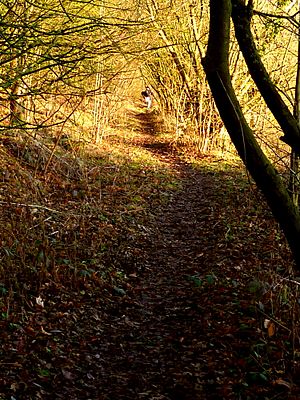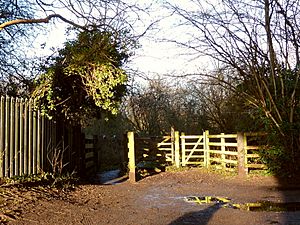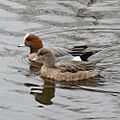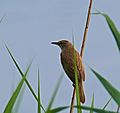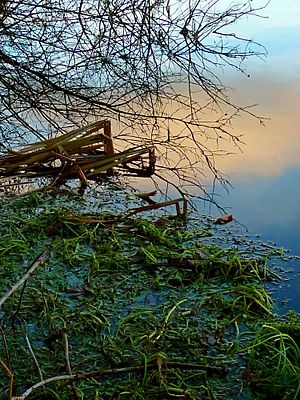Hay-a-Park Gravel Pit facts for kids
| Site of Special Scientific Interest | |
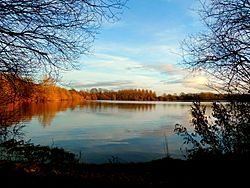
Hay-a-Park Lake
|
|
| Area of Search | North Yorkshire |
|---|---|
| Coordinates | 54°00′54″N 01°27′00″W / 54.01500°N 1.45000°W |
| Interest | Biological |
| Area | 44.8687 hectares (0.4487 km2; 0.1732 sq mi) |
| Notification | 15 June 1995 |
| Location map | Magic Map (Defra) |
Hay-a-Park Gravel Pit is a special nature spot called a Site of Special Scientific Interest (SSSI). It's located next to Knaresborough in North Yorkshire, England. This area used to be a quarry where people dug for gravel. It closed in the 1970s and then filled with water.
Today, Hay-a-Park is home to a big lake, three smaller ponds, and areas of reedbeds, bushes, woodland, and grassland. It became an SSSI in 1995 because many birds spend their winters here. A large group of goosander birds are often seen. It's also one of the most northern places in Britain where reed warbler birds breed. Hay-a-Park was once part of a royal park, owned by kings like Edward II.
Contents
A Royal Park: Hay-a-Park's History
This land was once owned by the King of England. King Edward II gave it to his friend, Piers Gaveston. After Gaveston died, the land went back to the Crown.
In the 1300s, the area was known as Park de la Haye. King Edward III used it to breed horses. His wife, Philippa of Hainault, received this land when she was fifteen and got married. She later became the mother of famous figures like the Black Prince and John of Gaunt.
Later, the area became known as Haya Park. By the 1600s, parts of the land had trees and were used for wood. In the 1800s, a part of Hay-a-Park became a gravel works. The site has been mostly untouched since the gravel digging stopped in the early 1970s.
Exploring Hay-a-Park: Location and Rules
Hay-a-Park Gravel Pit is a Site of Special Scientific Interest (SSSI) that covers about 45 hectares (about 110 acres). It's mainly made up of open water. This nature reserve does not have a car park or special visitor facilities.
You can reach the site by public footpaths from Park Lane in Knaresborough. There are two entrances without signs. One is near the railway bridge, and the other is next to Knaresborough Rugby Club. To protect the wildlife, fishing and swimming are not allowed. Dog walking is also discouraged because it can disturb the water birds.
The site was officially recognized as an SSSI on June 15, 1995. It's important for its breeding birds and wintering wildfowl (water birds). Hay-a-Park Lake, which is 24 hectares, is at the north end. There are also three small ponds at the south end. The site includes areas of reedbeds, bushes, and grassland.
Amazing Animals at Hay-a-Park
Birds and Their Habitats
Many birds find a home at Hay-a-Park. The goosander birds are very important. Up to 315 of these birds have been counted here in winter. Other important birds include wigeon, greylag geese, coot, and mallard.
In spring, oystercatchers, wigeon, and different geese eat in the nearby fields. Tufted ducks, mallards, and great crested grebes breed on or near Hay-a-Park Lake. You might also spot common sandpipers and ringed plovers breeding here.
Smaller ponds are home to grasshopper warblers and sedge warblers. The reed warbler also breeds here. This is one of the most northern inland places in Britain where reed warblers raise their young.
-
Male goosander
Insects Found Here
Some interesting insects have been found at Hay-a-Park. The fly Raphium laticorne has been seen here. Another fly, Campsicnemus marginatus, also lives at this site.
Wonderful Plants at Hay-a-Park
Hay-a-Park is also home to a variety of plants and trees. You can find different types of trees, moss, and fungi.
Caring for Hay-a-Park: Maintenance Efforts
Even though Hay-a-Park Lake might be deep, it's important to keep some areas shallow. These shallow waters are great for wintering wading birds and for ducks and geese to find food. Shallow areas also let sunlight reach aquatic plants. This helps create good conditions for dragonflies and damselflies to breed.
It's also important to keep the water clean and control how much water and dirt enter the lake. Certain "bottom feeding coarse fish" are removed. This is because they can pull up plants and stir up the lake bottom. The people who manage the site make sure there are good nesting and feeding spots for birds in the open land, bushes, and reeded areas.
Recreational activities, like walking, should be managed carefully. This helps make sure they don't harm the nature conservation efforts. If there's a heronry (a place where herons nest) in the woodland, people are encouraged not to use that area for recreation.
Images for kids


